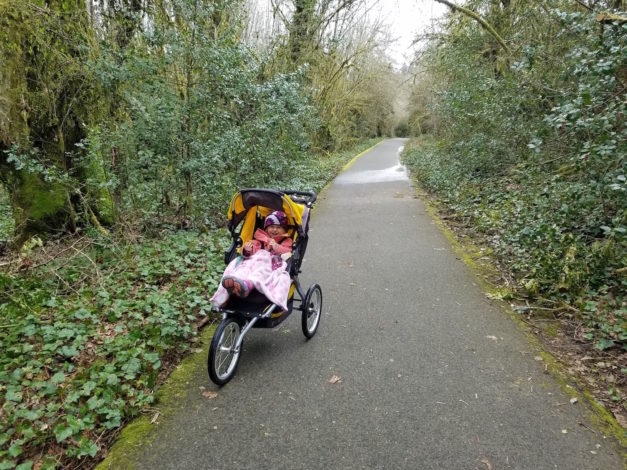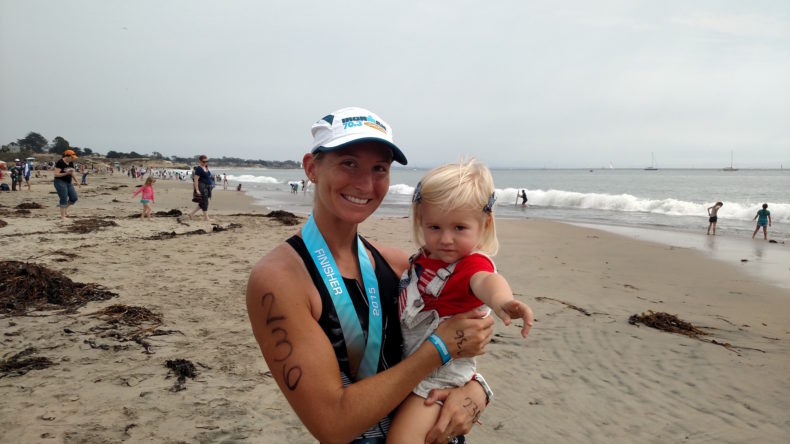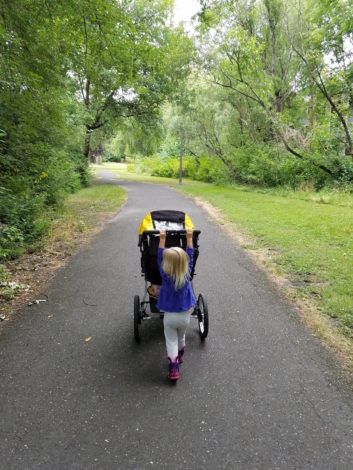Running with Your Toddler
Some of the more gratifying moments as a parent are when our kids emulate our better tendencies and qualities. One day I rounded the corner to find my daughter pushing her plastic shopping cart down the hall at high speed, crashing into the corners at every turn. I was instantly annoyed until she informed me that she was out for a run and was taking her stuffed animals out in their running stroller so they could have fun. She had them gently tucked in with blankets and had packed toys, snacks, and water for everyone. I softened instantly – who needs pristine walls when we had a little runner on our hands?
Running is different with a Toddler
Somewhere a little after a year, my daughter started walking and stopped napping in the stroller (or pretty much ever…) and my well-choreographed running plan fell apart a little. I pushed aside my stubborn adherence to ritual and we switched to a new time and changed a few of our habits and were back up to enjoying our runs again. Running with a baby has its challenges, but toddlers suddenly have an all new set of needs. Whining and snack demanding aside, they are way more fun running buddies. If your toddler has run in the stroller since they were a baby, then they will be used to the routine of running. It is harder to start from scratch, but most of these suggestions would work just as well if this is their first time heading out for the open road with you.


Running is different with a Toddler
Somewhere a little after a year, my daughter started walking and stopped napping in the stroller (or pretty much ever…) and my well-choreographed running plan fell apart a little. I pushed aside my stubborn adherence to ritual and we switched to a new time and changed a few of our habits and were back up to enjoying our runs again. Running with a baby has its challenges, but toddlers suddenly have an all new set of needs. Whining and snack demanding aside, they are way more fun running buddies. If your toddler has run in the stroller since they were a baby, then they will be used to the routine of running. It is harder to start from scratch, but most of these suggestions would work just as well if this is their first time heading out for the open road with you.
Make running fun for everyone
The most important factor is your attitude about running; how you approach running each time will impact how they feel about hopping into the stroller. You don’t have to go for a run; you get to go for a run. They are not just getting in the stroller ... they are going for an adventure or going to see the flowers, squirrels, or construction trucks. For toddlers, involving them in the process in whatever way you can makes it more fun and exciting for them. Before you leave the house, let your child pick what toys or books they want to bring with them in the stroller. At times, we have even had a stash of toys that were only for the stroller so she was excited to get to play with them on the run. Bring quadruple the amount of snacks you normally would. Snacks keep them entertained and not hungry and therefore happier. In most strollers, they sit comfortably so they can really eat anything except the messiest of snacks. Try and pick a spot to run that has a fun pit stop or destination for them. I love to try to start and end at a playground so she knows at the end she will get her chance to play also. Be willing to get some extra cardio in to sing, chat, and answer questions on your run. Point out fun sights on the route or give them ideas of things to look for (birds, airplanes, squirrels). Also, you can involve them in the workout by cheering you on or even holding a stop watch and keeping time for you once they are older. We sometimes play Motorboat at the end of the workout (motorboat, motorboat goes so slow – walk, goes so fast – jog, step on the gas – sprint). This is good for short intervals and lots of child giggles. Try to manage your expectations, but don’t make excuses. Your kiddo is going to have an off day and you are not going to get your workout in on some days. Just because they are whining or fussy, if you put a little bit of extra effort in, you can still get done what you wanted to and change their mood for the better.
Don't give up on your goals
Once you can find ways to keep your active little one happy, you can also start getting more creative with incorporating different workouts into your running. If you are doing more serious training, be sure to warm up, stretch and cool down. I always stretch in front of the stroller so she can see me. Sometimes, I even let her hop out and stretch with me. Don’t be afraid of incorporating intervals, sprinting or hills into your stroller running. You should be more conscious of your effort level and what feels safe, but you can still build strength, speed, and endurance while pushing the stroller. Plan what workout you intend to do ahead of time so you can be better prepared mentally and able to make the event go smoothly. Keep setting big goals for yourself. Your path to get there will be different, but you don’t have to shelve your dreams of running a half marathon, a full marathon, a triathlon…and beyond. It’s fun to keep track of small victories and PRs too – longest stroller run, stroller 5K fastest time, fastest time running a certain familiar loop. These milestones are sometimes harder fought than the ones on race day. I am often surprised how far and long my daughter will tolerate and even enjoy running if I explain what we are going to do and why I want to run that far to accomplish my goal of completing a race. It’s all about keeping it a positive experience.
Involve them in the process and achievement
A huge part of successful running with my daughter, that my husband was much more adamant about than I was at first, is if I am going to race, then she is going to come and see me race. He told me that she was putting in the hours in the stroller and she could tell how important running is to me. Therefore, she needed to see the culmination. She has seen me in the hot sun and the cold rain, sprinting by with a smile, and shuffling along trying to hide the pain. She has seen me run across the finish line and scoop her up in triumph. And she has seen me stumble across the finish line barely able to pick her off the ground. She watches Mom running, persevering, and accomplishing goals and she feels like she is part of that process and that achievement.Related Content




Comments